The iPhone SE Review
by Brandon Chester on May 16, 2016 8:00 AM EST- Posted in
- Smartphones
- Apple
- Mobile
- iPhone
- iPhone SE
System Performance
With the iPhone SE I've decided to make the transition to our 2016 benchmark suite. We've been including some of these for a little while now, and some tests from our previous suite are still around. There is one test omitted, which is Basemark ES / Basemark Metal, which we'll be deploying once we have all the data from this year's flagship Android smartphones. Comparisons to those Android phones will also have to wait until their respective reviews, and for now I can only really compare the iPhone SE to Apple's other iPhones along with 2015's flagship Android devices.
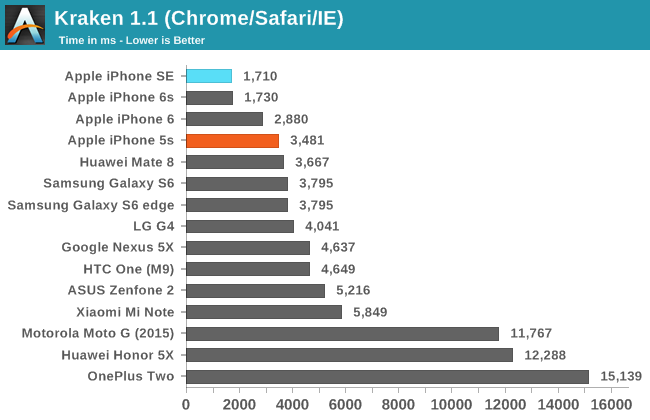
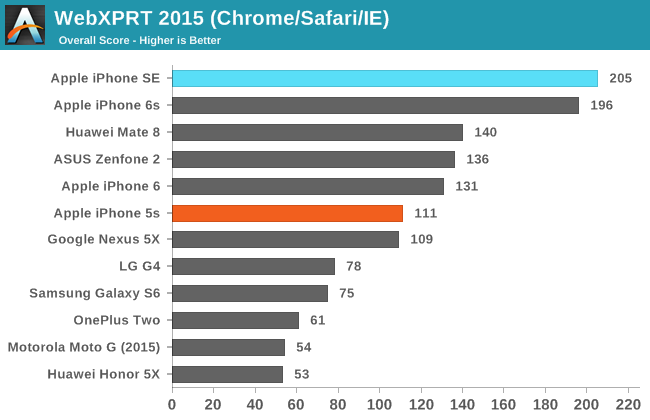
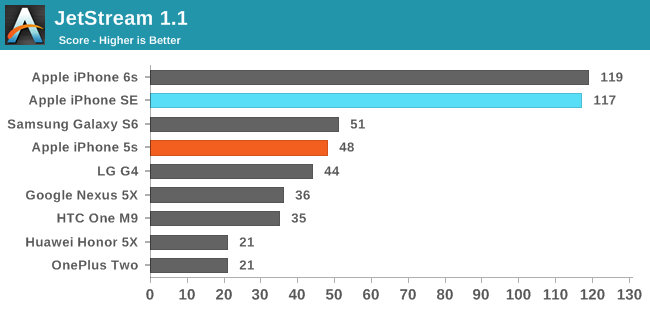
At this point I think we're ready to move to our 2016 web browser benchmarks. Octane is now retired, as there's a large degree of overlap between it and JetStream, with JetStream using a more sensible methodology with measurements for tests like the mandreel-latency test. Kraken, Octane, and Jetstream all have some overlap, but Kraken and JetStream are different enough to make it worth keeping Kraken on. Finally there's WebXPRT 2015, which we already introduced as a replacement for WebXPRT 2013 some time ago.
As expected, the iPhone SE matches the iPhone 6s in our JavaScript tests. The improvement over the iPhone 5s is significant, with roughly double the performance in all cases. This is right in line with Apple's 2x performance claim, and it's important to note that these are updated iPhone 5s figures run on iOS 9 to ensure that it also benefits from the improvements made to Apple's Nitro JavaScript engine since it launched in 2013.
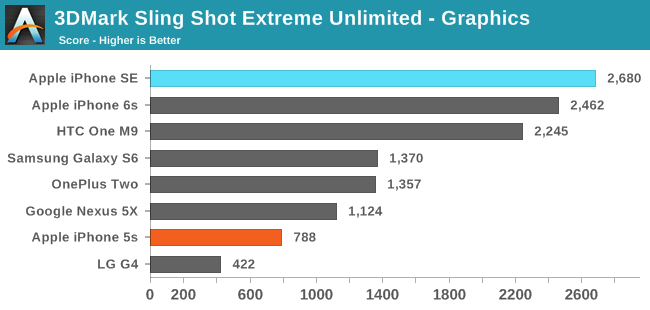
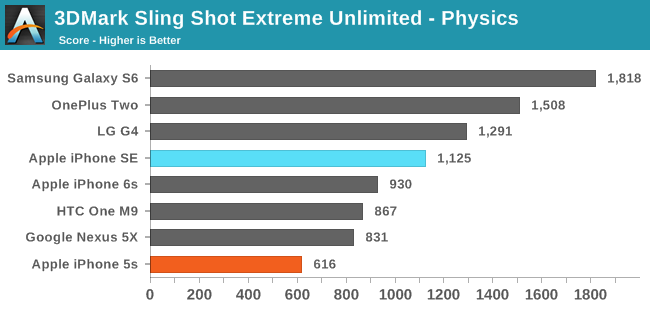
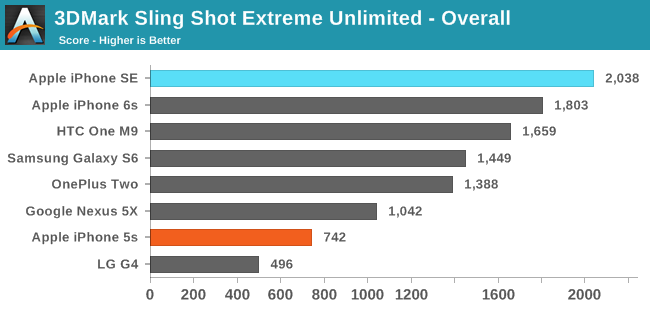
We originally planned to use 3DMark Sling Shot Unlimited, which is an OpenGL ES 3.0 test that runs off screen 1920 x 1080 tests to produce results that are useful for comparing devices and SoCs. However, in the interest of test longevity we have moved to the even newer Sling Shot Extreme test, which uses OpenGL ES 3.1 on Android and Metal on iOS, with a Vulkan version coming to Android in the future. The tests in Sling Shot Extreme render off screen at 2560 x 1440, so it should be a good target for GPU performance well into the future.
In this test the iPhone SE performs well. I experienced a strange situation where the iPhone 6s would consistently score lower than the SE, and I'm not sure if this is due to driver differences or some other problem, but in any case the SE and the 6s both end up at the top of the chart, and the final score is nearly three times higher than that of the iPhone 5s. I'm still waiting on final reviews for this year's Android flagships, so comparisons to Snapdragon 820 and Exynos 8890 will have to wait a bit longer.
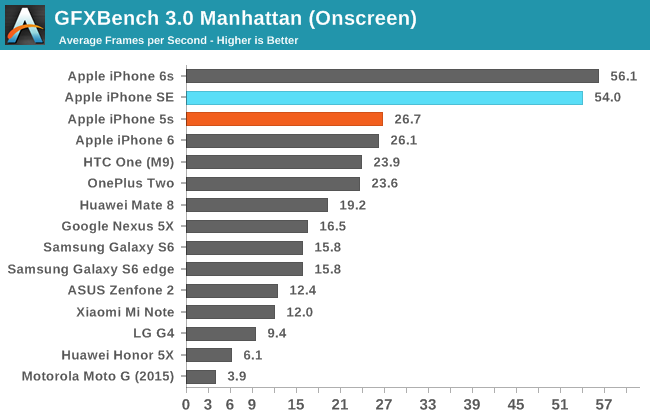
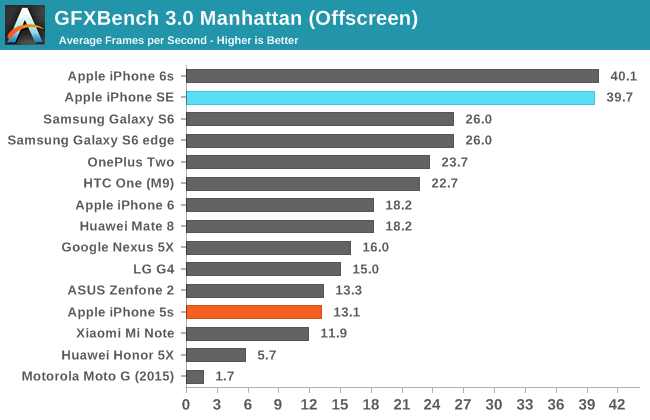
With T-Rex HD being such an old test, I've decided to retire it except perhaps for reviews of devices with relatively slow SoCs. That leaves GFXBench 3.0 Manhattan, and hopefully GFXBench 4.0 in the near future. In Manhattan the iPhone SE performs exceptionally well, achieving a frame rate that is ever so slightly more than three times that of the iPhone 5s. While there's obviously a degree of variance, I think this shows that Apple's 3x GPU performance claim is not an exaggeration, and on such a tiny display with a relatively low resolution you can render a scene like Manhattan at native resolution and almost achieve 60fps.
NAND Performance
With the first generation of the MacBook, Apple introduced their own PCI-E SSD controller with support for NVMe. At the launch of the iPhone 6s and iPad Pro, they noted that both devices had significantly improved storage performance. During the course of our review we discovered that Apple had essentially brought some version of their controller down to their mobile devices, and as a result they led the rest of the mobile market by a large margin when it came to overall storage performance.
With the iPhone SE, Apple uses the same controller as they do in the iPhone 6s and iPad Pro. Since this iPhone is a 64GB unit, we can take a look at the potential impact of a smaller SSD that may not be able to utilize parallelism to achieve the same performance as its 128GB and 256GB counterparts in Apple's other devices. To analyze the storage performance of the iPhone SE I've used StorageBench, a NAND benchmark developed by Eric Patno which is comparable to our AndroBench 3.6 test on Android.

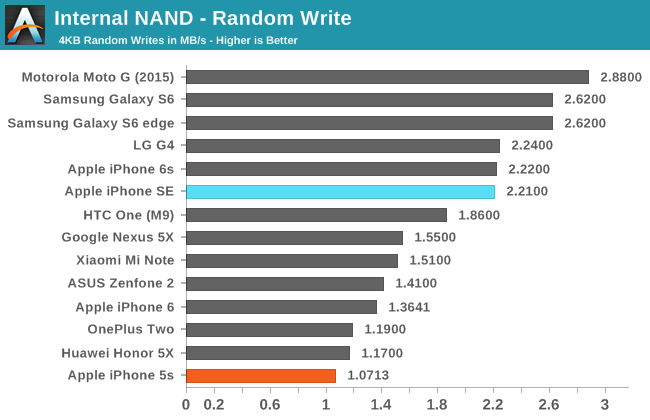
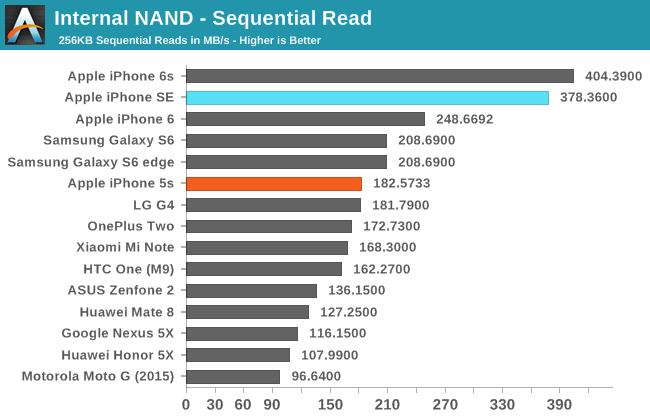
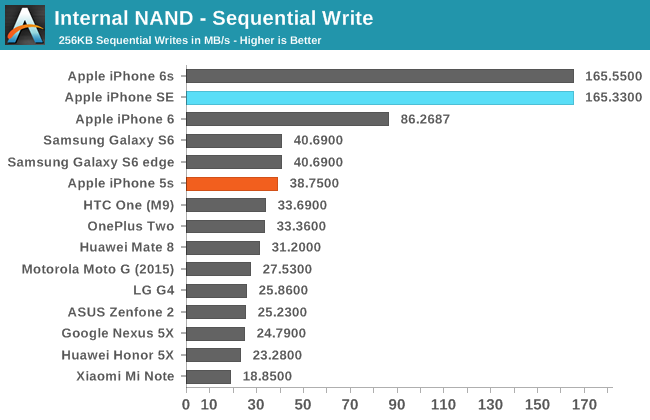
Despite the fact that the storage capacity is half that of our iPhone 6s review unit, the iPhone SE performs essentially just as well. Random reads actually end up being faster, while random writes are nearly identical. Sequential reads trail the 6s by a bit, but sequential writes end up being identical much like random writes. The differences are enough to attribute to testing variance, and it's probably safe to say that the storage performance on the 64GB iPhone SE is identical to that of the 64GB and 128GB models of the iPhone 6s.










138 Comments
View All Comments
michael2k - Monday, May 16, 2016 - link
You're curious how much faster the iPhone SE is than the Galaxy S7? Just look for iPhone 6S and you'll see, given the SE uses the same SoC as the 6S:http://www.anandtech.com/show/10120/the-samsung-ga...
osxandwindows - Monday, May 16, 2016 - link
I can't wait for the "anandtech is so biased" comments to show up.Alexey291 - Monday, May 16, 2016 - link
Ah yes the first of the flame bait comment, so soon too...That said I did giggle at the excuse that he can't use non review data in a review. I'm pretty sure I've seen that happen far more than once. But yeah whatever. It's just a phone
extide - Tuesday, May 17, 2016 - link
That's not what he said. He said he can't use data that he doesnt have.xmrv - Sunday, May 22, 2016 - link
sheeps dont do that so you wont see any comments like that on this site...DesertCat - Monday, May 16, 2016 - link
Thanks for the article. I have some friends wanting to stick with the smaller form factor and will forward your review along.One quibble from the Experience page: "X fewer emails in the Mail app"
I'm guessing that was a place holder waiting for you to update with the number after you looked it up. May want to get that edit in. ;)
MonkeyPaw - Monday, May 16, 2016 - link
It's a little bit of a lazy effort from Apple, but it should still be a crowd pleaser. The issue is that you can get a much bigger display in the footprint of the SE. I believe the Xperia Compact is almost the same size as the SE, but can offer a 4.6" display instead. That big thumb button is really costly on Apple devices.Aenean144 - Monday, May 16, 2016 - link
No, it really isn't. The Touch ID home button has been a huge advantage, well worth the costs of poorer screen-to-body ratios. Maybe in the future the button goes away, but it has served Apple and Samsung quite well.iPhone 5/5S/SE
dimensions: 12.4 x 5.9 x 0.76 cm
footprint: 73.2 cm^2
volume: 55.6 cm^3
Xperia Z5 compact
dimensions: 12.7 x 6.5 x 0.89 cm
footprint: 82.6 cm^2
volume: 73.5 cm^3
Xperia Z3 Compact
dimensions: 12.7 x 6.5 x 0.86 cm
footprint: 82.6 cm^2
volume: 71.0 cm^3
iPhone 6
dimensions: 13.8 x 6.7 x 0.69 cm
footprint: 92.5 cm^2
volume: 59.2 cm^3
iPhone 6S
dimensions: 13.8 x 6.7 x 0.71 cm
footprint: 92.5 cm^2
volume: 60.9 cm^3
The footprint of the Xperia "Compacts" are indeed small, but both the iPhone 5 and 6 models are smaller then them in there own ways. 5/5S/SE are smaller by 10% in footprint and 25% in volume. The iPhone 6/6S have smaller volumes by 15%.
An iPhone SE will definitely feel smaller than the Xperia Compacts, while the 6/6S may feel smaller then them depending on users favoring the thinnes. The Xperias also have onscreen home, back, multitasking keys, so that 4.6" has something like 4.2" of application space for many apps.
mooncancook - Monday, May 16, 2016 - link
Partially true regarding onscreen home/back keys. On lots of apps they auto hide so the app can use the entire screen, and you swipe that area to bring the keys up.ianmills - Monday, May 16, 2016 - link
Chinese phones put the touch ID just under the camera lense. It works great (at least on bigger phones) because thats where your finger naturally rests